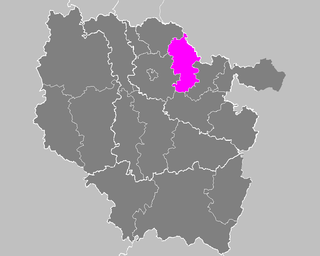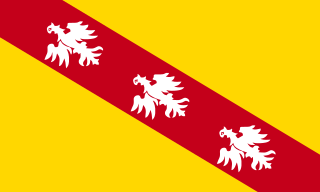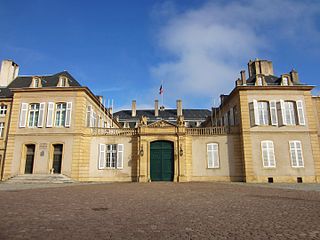
The arrondissement of Boulay-Moselle is a former arrondissement of France in the Moselle department in the Lorraine region. In 2015 it was merged into the new arrondissement of Forbach-Boulay-Moselle. It had three cantons and 96 communes.

The arrondissement of Forbach is a former arrondissement of France in the Moselle department in the Lorraine region. In 2015 it was merged into the new arrondissement of Forbach-Boulay-Moselle. It had seven cantons and 73 communes.
The following is a list of the 27 cantons of the Moselle department, in France, following the French canton reorganisation which came into effect in March 2015:
The 1st Canton of Saint-Avold is a French former administrative division, located in the arrondissement of Forbach, in the Moselle département. It was disbanded following the French canton reorganisation which came into effect in March 2015. It had 28,837 inhabitants as of 1999.
The 2nd Canton of Saint-Avold is a French former administrative division, located in the arrondissement of Forbach, in the Moselle département. It was disbanded following the French canton reorganisation which came into effect in March 2015. It had 39,674 inhabitants in 1999.

Forbach railway station is a railway station in Forbach in the Moselle department of north-eastern France. It is the last station in France before the German border at Saarbrücken.

The 6th constituency of Moselle is one of the nine legislative constituencies in the Moselle département (Lorraine).

The arrondissement of Forbach-Boulay-Moselle is an arrondissement of France in the Moselle department in the Grand Est region. It was created at the 2015 arrondissements reform by the merger of the former arrondissements of Forbach and Boulay-Moselle. It has 169 communes.
The canton of Algrange is an administrative division of the Moselle department, northeastern France. Its borders were modified at the French canton reorganisation which came into effect in March 2015. Its seat is in Algrange.
The canton of Boulay-Moselle is an administrative division of the Moselle department, northeastern France. Its borders were modified at the French canton reorganisation which came into effect in March 2015. Its seat is in Boulay-Moselle.
The canton of Bouzonville is an administrative division of the Moselle department, northeastern France. Its borders were modified at the French canton reorganisation which came into effect in March 2015. Its seat is in Bouzonville.
The canton of Fameck is an administrative division of the Moselle department, northeastern France. Its borders were modified at the French canton reorganisation which came into effect in March 2015. Its seat is in Fameck.
The canton of Freyming-Merlebach is an administrative division of the Moselle department, northeastern France. Its borders were modified at the French canton reorganisation which came into effect in March 2015. Its seat is in Freyming-Merlebach.
The canton of Hayange is an administrative division of the Moselle department, northeastern France. Its borders were modified at the French canton reorganisation which came into effect in March 2015. Its seat is in Hayange.
The cantons of Metz are administrative divisions of the Moselle department, in northeastern France. Since the French canton reorganisation which came into effect in March 2015, the city of Metz is subdivided into 3 cantons. Their seat is in Metz.
The canton of Metzervisse is an administrative division of the Moselle department, northeastern France. Its borders were not modified at the French canton reorganisation which came into effect in March 2015. Its seat is in Metzervisse.
The canton of Montigny-lès-Metz is an administrative division of the Moselle department, northeastern France. Its borders were modified at the French canton reorganisation which came into effect in March 2015. Its seat is in Montigny-lès-Metz.
The canton of Le Sillon Mosellan is an administrative division of the Moselle department, northeastern France. It was created at the French canton reorganisation which came into effect in March 2015. Its seat is in Maizières-lès-Metz.
The canton of Stiring-Wendel is an administrative division of the Moselle department, northeastern France. Its borders were modified at the French canton reorganisation which came into effect in March 2015. Its seat is in Stiring-Wendel.
The canton of Yutz is an administrative division of the Moselle department, northeastern France. Its borders were modified at the French canton reorganisation which came into effect in March 2015. Its seat is in Yutz.






